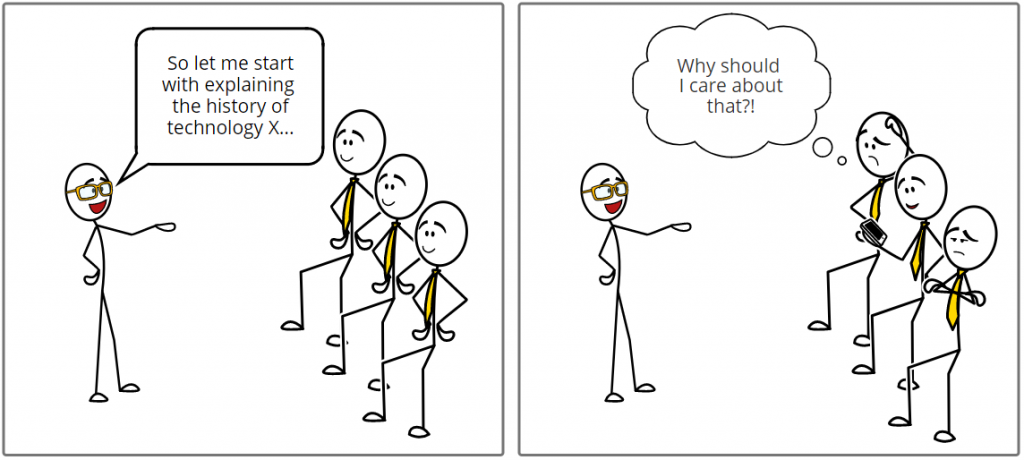
You spot a catchy presentation topic, so you start feeling excited. Its presenter seems to be an expert too, which makes your expectations grow even higher. Deep inside you think:
“Wow, that’s so awesome, I need to go to that conference.”
Finally, you get there, you sit in a chair and here it goes. The presenter walks onto the stage, people are clapping their hands and the show begins. But after a while you know that it’s going to be a waste of time. You’re disappointed. You were expecting an interesting show full of captivating content but it turns out to be a fiasco with boring slides and a very unemotional presenter. The only thing on your mind right now is how to get out of this room. That’s how I felt the last time I attended a presentation. It turned out to be a 2-hour waste of time and one of the worst presentations in my life.
Unfortunately, this happens quite often and it concerns not only short, hour-long presentations but also trainings that last a few days. That’s unbelievable! What a waste of time and energy. That situation inspired me to write down the biggest presentation mistakes you can make as a presenter. People across different companies, industries and with different expertise and experience repeat similar mistakes. The reasons that make a bad presentation bad are the same for all presenters. Here’s my list of top 6 mistakes you should avoid while giving any kind of presentation in order not only to save your reputation but also not to kill your audience.
#1 Not addressing your listener’s needs
Every information should bring you closer to achieving your presentation goal. If it is to show that your product is a great choice, each slide should amplify that. If you want to persuade others of your solution, each piece of information and each one of your examples, should help them realize your solution is worth considering. If you want to train your team on how to use a new platform, each module you explain should be relevant to them. Don’t add any extra meaningless information.
I participated in many trainings, especially technical ones, which started with a slide describing a company’s or a product’s history.

And then people would have to listen to differences between a 1.1 version of the platform and its 1.2 version for at least 15 minutes. Even though they didn’t know anything about that platform yet. What would be the point of presenting its history before explaining the basics of the platform? And when I asked presenters why they did it this way, the answer was usually something like:
“You know, everybody does that! I’ve attended many trainings and presenters always use that common structure.”
That sort of attitude is completely wrong. You cannot blindly follow the standards simply because it sounds rather reasonable. Before adding any information to your presentation, you need to ask yourself whether it helps you achieve the presentation goal. Every time I create a new slide and fill in its title, I ask myself: “Why should my listeners care about that information?”. And then I leave it or delete it. I know it seems obvious but for many presenters it’s not.
Don’t make assumptions that you need to present a particular piece of data just because every other presenter thinks it’s obligatory. Put people’s needs first. That’s the fundamental rule.
#2 Boring your audience
If any information you put in your presentation doesn’t excite you, don’t expect it will excite others. No matter how important and valuable it is, it doesn’t automatically become interesting for your audience. You need to be twice as judgmental as people listening to you. Every time you find a certain piece of information boring or you see people getting bored with it, ask yourself the question: ”Why isn’t it exciting?”. Typically, the answer is: “Because it is irrelevant to your audience” or ”Because it is simply vague or overwhelming” or “Because you just cannot present it in an engaging way”.

When you answer that question and find a root cause why it’s boring, try to fix it. Look at a problem from different angles. Create a story instead of just presenting the raw numbers. Add an anecdote. Do something to present it in another, more engaging way.
For example, if you want to present financial data, don’t rely purely on numbers and mundane charts exported from Excel. Put a story behind the numbers. If your company’s income is going up, first focus on what it means to others. Raw data is boring. The audience needs to understand how it impacts them. Maybe it means the company is looking for new employees or maybe new projects are going to be launched soon. When you have the answer, think about making the content more engaging. Support the numbers with a story of how salespeople managed to win a profitable deal. Numbers are never close to people but stories are.
Believe me, every piece of information can be presented in an engaging way. If you struggle with boring data, please let me know and I’ll help you modify it into a thrilling story.
#3 Using monotonous voice
“Wow, that guy is too exuberant while presenting” or “I cannot stand it, this presenter is too excited”. Have you ever heard that? I haven’t. But I have heard (and experienced) presenters who were boring, unenthusiastic and made people fall asleep during their presentation. That issue often intensifies the previous one.
Put some emotion into your speech and show people that you’re motivated to talk to them. I’m not asking you to fake your enthusiasm. You need to be authentic. And in order to be authentically enthusiastic you need to believe in what you’re saying and you need to be sure you’re meeting your listeners’ needs. If you don’t sound motivated, people won’t feel motivated either.
There are a lot of methods of improving your speech. But the most elementary technique that can be used by every speaker is to place emphasis on a specific word or a phrase. If you want to remind your audience that tomorrow there will be a party after a training session, you can place stress on the word “tomorrow”. Say this word a bit louder and slower. You can even pause for a second after saying “tomorrow” just to grab people’s attention and underline what’s important to them.
I know that speaking in a confident and interesting manner is not an easy skill. But even if you’re not a natural born TedX speaker, you can learn it. The way you speak makes a huge difference in every presentation delivery. Don’t let people fall asleep while you’re presenting.
#4 Putting too much information into one speech
I know that as a presenter or a trainer you want to share as much data as you can. You feel accomplished when you cover all aspects regarding any topic. It makes you feel wise. But people don’t need all the information you have. I know it’s hard to hear but if you want to be a great presenter you need to deal with this issue. People don’t want to hear everything you know. They don’t want to feel overwhelmed or start doubting themselves: “Oh no, that presenter knows so much and I know so little”.
Putting too much information can confuse your audience. It’s hard to say how much information you should cover in your presentation but typically, it’s less than you think. It’s better to present less information and to be consistent rather than to cover every single aspect in a short period of time.
And again, go back to the first issue and think about the audience’s needs. Every piece of information should help meet the presentation goal and it should be relevant to your audience. I know you can have lots of facts and data in your head but leave some of it to yourself. As Winston Churchill said:
“’A good speech should be like a woman’s skirt; long enough to cover the subject and short enough to create interest.”
If you want to present an idea of using new technology in a project, don’t put too much information into that pitch. You don’t need to present the full history, all its features, main competitors, market analysis and recent trends when you just want to show the advantages of your solution. Focus on the most relevant aspects and be goal-oriented. If you make your audience interested, they will ask you for more. That I can guarantee.
#5 Reading slides, not speaking
A presentation may have many different goals. For instance, it can be informative of a new product, persuasive of a particular solution or simply educational for certain purposes. But there is one common goal to each and every presentation. It’s to make a real connection with people. You should build trust and make your audience feel that you speak directly to them, not to yourself (yes, I’ve seen such presentations).
The biggest sin that makes you look unauthentic and boring is when you simply read the text from your slides. That makes your credibility disappear. After all, can you imagine Steve Jobs or Bill Gates reading PowerPoint slides while presenting a new device?
You need to be prepared enough to speak to the audience without any slides. This is just a tool designed to support your message. It is you who makes the show. You and your knowledge on the subject you present. Slides are just an addition to your speech.